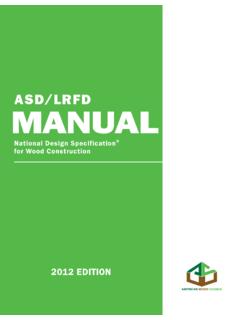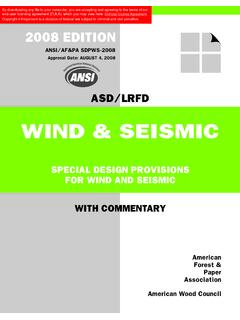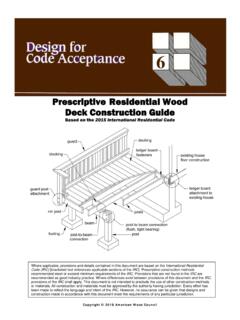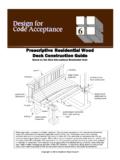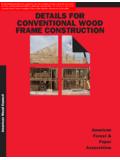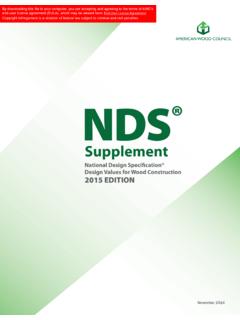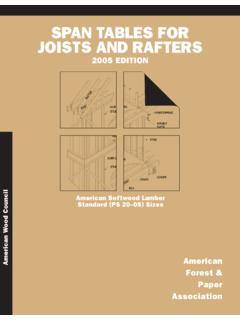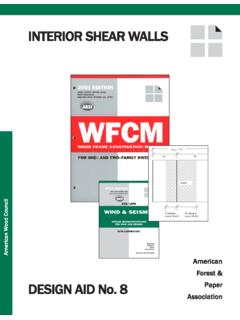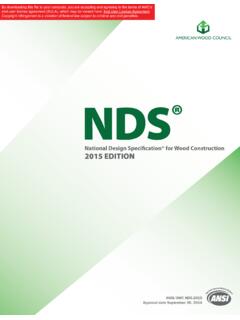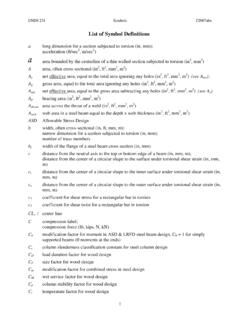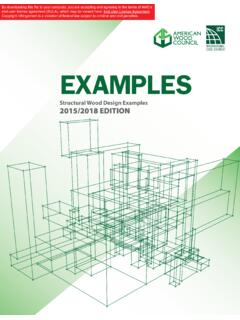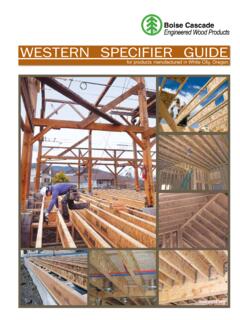Transcription of MAT100: The Basics of Wood Frame Construction
1 AMERICAN FOREST & PAPER ASSOCIATION. American Wood Council Engineered and Traditional Wood Products MAT100: The Basics of Wood Frame Construction Copyright 2003 - 2007 American Forest & Paper Association, Inc. All rights reserved. Welcome to eCourse MAT 100: The Basics of Wood Frame Construction . Copyright 2004 2007 American Forest & Paper Association. 1. All rights reserved. Copyright of Materials This presentation is protected by US and International copyright laws. Reproduction, distribution, display and use of the presentation without written permission of the American Forest & Paper Association /. American Wood Council is prohibited. Copyright 2003 - 2007 American Forest & Paper Association, Inc.
2 All rights reserved. 3. MAT100: Learning Outcomes By the end of this complete modular eCourse, you will be knowledgeable of: 1. IBC Chapter 23 format;. What is conventional Construction ? 2. Growth characteristics of wood; grade marks;. protection against termites &. decay MAT 100 is a complete eCourse composed of MAT 101 through MAT 110 in one comprehensive program for building officials on wood Frame Construction Basics . In each module, learning outcomes will be further refined respectively. MAT 100 learning outcomes (see slide). 4. MAT100: Learning Outcomes 3. Floor, roof/ceiling, wall framing 4. Wall bracing, introduction to Wood Frame Construction Manual 5.
3 Fireblocking & draftstopping Refined learning outcomes will be itemized within each module. MAT 100 learning outcomes continued (see slide). 5. Let's start at the beginning . Let's start at the beginning . 6. What Was the First Building Code? ?? What do suppose was the first building code? 7. What Was the First Building Code? ? Would you guess the 1927 edition of the Uniform Building Code? 8. Hammurabi's Code Regulated building Construction in the Babylonian Empire Perhaps you would guess the Laws of Hammurabi. Hammurabi's code regulated building Construction in the Babylonian Empire. 9. Hammurabi's Code 228 If the builder builds a house for a man and completes it, that man shall pay him two shekels of silver per sar (approximately 12 sf).
4 Of house as his wage. Hammurabi's Code was very prescriptive (see slide). 10. Hammurabi's Code 229 If a builder has built a house for a man and his work is not strong, and if the house he has built falls in and kills the householder, that builder shall be slain. But, Hammurabi's Code was also performance-based as evidence by rule 229 (see slide). You might say this is the ultimate performance-based code. 11. Hammurabi's Code 230 If a child of the householder is killed, the child of the builder shall be slain. Rule 230 If a child of the householder is killed, the child of the builder shall be slain. 12. Hammurabi's Code 231 If the slave of the householder be killed, he shall give slave for slave to the householder.
5 Rule 231 If the slave of the householder be killed, he shall give slave for slave to the householder. 13. Hammurabi's Code 232 If goods have been destroyed, he shall replace all that has been destroyed;. and because the house was not made strong, and it has fallen in, he shall restore the fallen house out of his own material. Rule 232 If goods have been destroyed, he shall replace all that has been destroyed; and because the house was not made strong, and it has fallen in, he shall restore the fallen house out of his own material. 14. Hammurabi's Code 233 If a builder has built a house for a man, and his work is not done properly and a wall shifts, then that builder shall make that wall good with his own silver.
6 233 If a builder has built a house for a man, and his work is not done properly and a wall shifts, then that builder shall make that wall good with his own silver. 15. We've Come a Long Way in a Few Thousand Years. THIRTEENTH EDITION. ISSUED EVE RY THREE YEARS. The BOCA National Building Code/ 1 996. 1997. U N IFORM. B UILDIN G. C ODE BOC BUILDING OFFICIALS & CODE ADMINISTRATORS. A. INTE RNATIONAL, INC. NTER L. I. NATI O NA. VOLUME 2. STRUCTURAL ENGINEERING. DESIGN PROVISIONS. UUI. BNIL. FDOIN. RMG. CODE. 1997. STANDARD. BUILDING. CODE. SBCCI. We've come a long way in a few thousand years. 16. Chapter 23 -- Wood Three design methodologies allowable stress design (ASD).
7 Load & resistance factor design (LRFD). Conventional Construction Although most of this program centers on the International Residential Code (IRC), keep in mind that the International Building Code (IBC) addresses wood Construction through one of three methods (see slide). 17. Chapter 23 -- Wood Three design methodologies allowable stress design (ASD). Load & resistance factor design (LRFD). Conventional Construction allowable stress design the old or traditional way of designing is an engineering methodology recognized by the IBC. 18. allowable Stress Design The code's reference document is the AF&PA allowable Stress Design (ASD) Manual, a group of several documents.
8 These are the Manual itself, the NDS, material-specific standards, and design guidelines. 19. allowable Stress Design - NDS . The 1997 National Design Specification (NDS) is the ASD. wood document referenced in the 2000. editions of the IBC &. IRC. The 2001 NDS is referenced in the 2003. codes. The NDS is the basic document in the ASD package and has been referenced in the codes for decades. 20. allowable Stress Design - NDS . Nationally accepted ANSI standard allowable stress design basis Contains design values for sawn & glued laminated lumber The NDS is: Nationally accepted ANSI standard allowable stress design basis Contains design values for sawn & glued laminated lumber 21.
9 Chapter 23 -- Wood Three design methodologies allowable stress design (ASD). Load & resistance factor design (LRFD). Conventional Construction Load and Resistance Factor Design (LRFD) is the second engineering design methodology recognized by the code and is, at least for the wood industry, relatively new. 22. LRFD Manual AF&PA/ASCE 16-95. Manual to a larger package 6 case studies 20 design examples 40 connection details Like the ASD Manual package, the LRFD Manual is a package of several smaller documents. 23. 2005 Wood Design Package ASD and LRFD together in the single-volume 2005. NDS : Provisions Supplement of Design Values Commentary Manual Worked example designs Wind & Seismic Standard Now you get ASD and LRFD in one package with the current 2005 NDS.
10 Bundled as the 2005 Wood Design Package. 24. Chapter 23 -- Wood Three design methodologies allowable stress design (ASD). Load & resistance factor design (LRFD). Conventional Construction And finally, the IBC recognizes conventional Construction as the third method of designing with wood. 25. Chapter 23 - Wood Conventional Construction in IBC has limited non- residential application Residential application is given to IRC. IBC Section (Scope): General applicability of IBC. Exception: Detached one- and two-family dwellings and multiple single-family dwellings (townhouses) not more than three stories high { not more than three stories above grade in height (as it appears in the 2003 edition)} with separate means of egress and their accessory structures shall comply with the International Residential Code.
